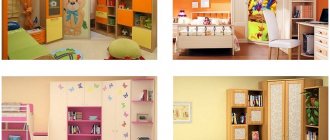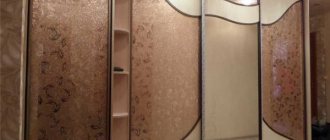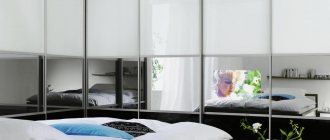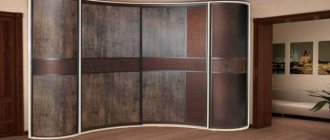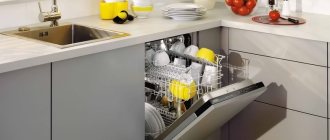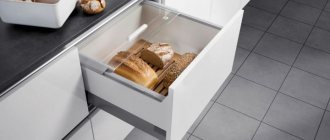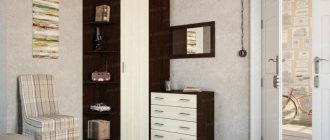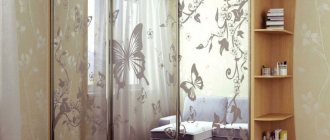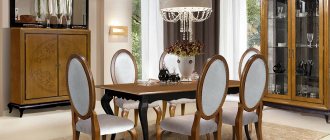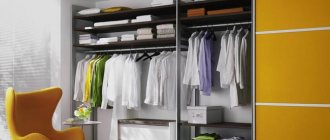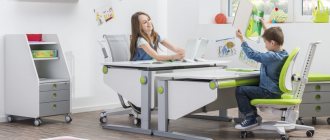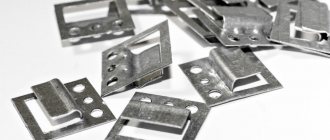Despite their apparent compactness, corner cabinets are very spacious. Their ergonomic design is also valued because it allows you to beautifully and functionally create a whole modular complex of cabinets, pencil cases, mirrors, cabinets and arrange them into a single composition. Drawings of corner cabinets with dimensions will help you create your own project for the bedroom, hallway, nursery or living room.
See also drawings of kitchen cabinets on our website.
This article discusses various options for internal filling for a corner cabinet with a height of 2200 mm and dimensions from a corner of 900x900 mm. With a side depth of 450 mm, a doorway 613.8 mm wide is formed, which is usually closed with two leaves.
You can easily adapt the proposed options “to suit yourself” by stretching or narrowing the drawing to the desired size. We will also consider how to do this correctly from the point of view of the rules for designing cabinet furniture.
Drawings of upper and lower corner cabinets
Let's look at drawings of various designs for the kitchen.
Read also: Physical depreciation of fixed assets
Curved facades and a corner with cabinets between them
A kitchen set in which the corner comes with rounded cabinets looks advantageous. This makes it possible to comfortably wash dishes and use the sink. This streamlined shape looks good with cabinets with curved doors on one wall.
The set will fit well into the following room dimensions: wall length 2420x1750 mm. This design has cabinets with curved fronts:
- 900x900 mm – floor corner;
- 600x600 mm – hinged corner;
- 320 mm if the product has curved doors;
- 600 mm – space for hood and built-in appliances.
The size is conditional, since in a large kitchen you can install a hood and a hob, each up to 90 cm wide. The size of a product with a curved facade depends on the radius of the door. If you change the width of the cabinet, then the facade will decrease or increase.
Standard dimensions
A corner kitchen cabinet must simultaneously correspond to the size of the kitchen, the technical characteristics, and the wishes of the customer. Today, sellers provide kitchen units of standard sizes that correspond to the size of the kitchen, but there are no strict norms and rules that would dictate their size. All dimensional ratios are dictated by the size of the specific kitchen. For example, an L-shaped “Khrushchev” kitchen will require a ratio of 2.6x1.2, and a “Brezhnev” kitchen will require a ratio of 2.8x1.8.
The height of the wall to the ceiling is also of great importance. In “Khrushchev” apartments, a headset height of 2150 mm will be needed, and in “Brezhnevka” apartments or in standard modern apartments it will exceed 2400 mm. If we talk about “Stalin” buildings, the height here often exceeds 3000 mm.
Standards for floor furniture:
- height – 850 mm;
- the thickness of the tabletop is calculated depending on the material and expected load;
- It is not recommended to make the depth of the tabletop less than 460 mm (the right drawer will take 450 mm + 10 mm will go into the gap to the back wall); it should protrude forward above the cabinet door by 5-30 mm.
Standards for wall furniture:
- height – 790-900 mm;
- depth – 300 mm;
- You should not hang the cabinet above a level of 2100 mm, and the distance from the countertop to the wall cabinet should be at least 450 mm;
- the sides adjacent to the walls are 600 mm, not taking into account the 130 mm cut;
- the walls that are adjacent to adjacent segments have a length of 315 mm each;
- the façade is 380 mm wide;
- the shelf must correspond to the weight of the utensils that are planned to be stored on it;
- the standard shelf thickness is 18 mm, but to store heavy items the shelf must be strengthened to 21 mm or more;
- there is no need to make boxes deeper than 400 mm, while taking into account the possible presence of communications (pipes, wires) passing near the wall;
- placing a wall cabinet above the kitchen stove sharply limits the height of the cabinet - there must be a sufficient gap between them;
- The standard of corner cabinets is 600x600 mm with a facade of 420 mm and a depth of 300 mm.
Video
Today, as I promised, we will look at corner modules.
This is a fairly simple topic, but for some reason it causes difficulties for many novice furniture makers.
And as an example, I propose to analyze the design of the most common upper trapezoidal box.
Its configuration may be different, depending on the purpose.
It can be a working one (have shelves inside, or a drying rack for dishes), or it can also be a “trick,” for example, to hide a gas boiler or water heater.
So, let's consider its version when there are shelves inside.
How the frame of a corner cabinet is constructed - elements, materials
The frame of a corner cabinet includes sides, a back wall, an upper and a lower horizon. Traditional materials are used for their manufacture:
- wood is rarely used, this is explained by the high cost and large weight of finished products;
- laminated chipboard allows you to make furniture affordable in terms of price, and its surface is available in different colors and textures;
- MDF will cost a little more, but its characteristics are higher than those of the previous type. The surface is decorated in the same way as chipboard.
Features of the internal filling of corner cabinets
The internal filling of the corner cabinet includes the same elements as other types of furniture. Its peculiarity is the presence of triangular shelves and inconvenient areas for use. The challenge is to use the entire volume rationally.
Diagonal and trapezoidal models cause the most difficulties. Corner shelves are suitable for storing small items. The space can also be adapted to place things of non-standard sizes (narrow and long) or equip this area with hooks for ties, belts, etc.
A barbell is usually installed in the space formed by walls located at an angle of 90°.
If the cabinet is L-shaped, you will need a central pole to secure the crossbars. If there is a partition in this area, you will have to put up with the inconvenience, and use the area located behind it to store seasonal items.
It will be easier to arrange the remaining elements. To organize storage according to ergonomic rules, the internal space is divided into 3 zones.
- In the upper part there is usually a mezzanine or a long shelf, as well as a bar equipped with a pantograph.
- The middle is intended for shelves (pull-out and stationary), drawers, baskets. As well as trousers and similar devices of a smaller size. A crossbar located parallel or perpendicular to the rear panel can also be installed here. The latter option is complemented by a retractable mechanism, which makes access to all wardrobe items easier.
- The lower space is filled with inclined shoe racks and a small bar for boots with high tops. They also store travel bags, suitcases, and household appliances (iron, vacuum cleaner).
Standard sizes
Experts insist that the first thing that is important to think about when choosing a corner cabinet is its size. After all, corner cabinets can have standard parameters, or they can be made to order according to a prepared project with specific measurements. The first option is characterized by lower cost, versatility, and practicality. There is no need to wait a long time for the manufacturer to create a custom-sized cabinet for you. It is enough to choose a ready-made model in the store with the necessary parameters, the design of which you like.
Triangular
If the room has the correct shape or decent dimensions, it is worth choosing a triangular corner wardrobe for it. The optimal length of the sides for such a triangular cabinet will be 1.2 m. If you make the sides of the structure too small (for example, sometimes you can find models with sides of 1 m), then the product will be of little functionality and not very spacious. If they are too large (for example, 1.5 m), then the furniture will turn out to be excessively bulky. The minimum depth of such a cabinet is 0.4 m, and the maximum is 0.6 m. Corner triangular cabinets with a depth of 0.45 m are often found. With a model depth of 0.6 m, experts advise using a regular crossbar for placing dresses on hangers. If the depth of the product is 0.4 m, you will have to use a special rod that allows you to place the hangers parallel to the door. A standard 0.55m wide hanger simply won't fit in a shallow closet.
For a small-sized triangular corner cabinet, it is better to prefer an L-shaped arrangement of shelves, since such filling of furniture will not be massive and will leave enough space for comfortable use of the room. To evaluate this visually, experts recommend drawing all types of sliding wardrobes on the plan of a specific room. Such drawings allow you to accurately calculate the area of the remaining free space.
Diagonal
If you consider the cross-section of such a compartment locker, it will be triangular, but the sides of such products will not be the same. Diagonal models are used for rooms with several doors or window openings located on adjacent walls. The parameters of corner wardrobes of diagonal type for the average living space of a city apartment are described in the table.
| Options | Minimum value, m | Maximum value, m |
| Height | 1,7 | 2,5 |
| Depth | 0,5 | 0,7 |
| Width on each side | 0,7 | 2,4 |
The optimal height of a diagonal model for a city apartment is considered to be 2.2-2.5 m, since the ceilings here are often 0.3-0.4 m high. That is, 5-6 shelves will fit inside.
When choosing the number of doors for a diagonal cabinet, experts recommend starting from its width. If a wide design is selected (for example, 2.2 m), then it should have three compartment doors (approximately 0.7 m each). This will give the model the maximum level of comfort.
Trapezoidal
The trapezoidal shape of corner cabinets is great for children's rooms, living rooms, kitchens, and offices. Such designs, as demonstrated in the following photo, are applicable even in a tiny entrance group, where every meter of free space counts. But due to their impressive depth, they are more recommended for installation in spacious rooms.
The level of capacity of such a model will be slightly higher than that of a similar-sized diagonal cabinet. This becomes clear if you consider a photo with a graphic representation of the compared structures.
Standard dimensions of a trapezoidal cabinet: the length of one wall is 1.2 m, the second - 0.8 m. A partition with a depth of 0.45 m is installed on the longer side, and a straight line is drawn from it to the short side. If you are selecting a cabinet for installing a sink in the kitchen, then the optimal height of the countertop is 0.85 m, the length of the side walls is 0.9x0.9 or 1.0x1.0 m, and the depth is 1-1.2 m.
The design of trapezoidal hanging cabinets for the kitchen is laconic and unusual at the same time. The dimensions of such structures are standard: 0.6x0.6 m.
Radial
Radius corner cabinets have a higher level of capacity due to the fact that the doors of such furniture are not flat, but somewhat convex outward. The door leaf moves to the sides not along straight guides, but along a semicircle, which allows you to give the piece of furniture a unique design. You can appreciate the beauty of radius structures in the following photo.
It is not difficult to fit such a design into a living space, because they, like other types of corner cabinets, are made in standard sizes. The height of a radius wardrobe for clothes can vary from 1.8 to 2.4 m, width - from 1.2 to 2.1 m, and depth - from 85 cm to 1 m. If we talk about a wardrobe for a kitchen , then manufacturers often offer models with parameters of 0.9 by 0.9 m, a height of 0.85 m and a depth of 1 m.
But it is better not to choose it for narrow spaces. Radius models require slightly more space than products with flat doors, so it is optimal to install a radius wardrobe in a spacious living room. In addition, the more complex design of the sliding system affects its cost. Radius models are sold at higher prices, so they are used mainly to create original, respectable interiors. In a bedroom with a budget renovation, the design of which is made as simple as possible, it is irrational to buy such furniture.
How to mark cabinet parts for drilling
Expert opinion Ekaterina Anatolyevna Smirnova has been engaged in interior design for 7 years, a professional architect
If you correctly mark and drill all the parts for the corner cabinet with your own hands, then in the end it will be assembled very simply, like a construction set. The most convenient way to do this is in special furniture programs, for example, Basis Furniture Maker.
- Furniture is assembled using Euroscrews (confirmats).
- The parts are drilled into the end and from the front side.
- The distance from the edge of the front side part should be the same. For example, 50 mm. Or in the center.
After the fasteners are placed, we number the parts. If there are parts of the same size, but with different fastening principles, we use additional markings (a, b, etc.).
In Basis Furniture Maker you can get specifications for drilling in this form. But here you need to be careful, clearly understand where the “face” of the corner cabinet part is, and where the “wrong side” is, along the edge-rolled sides.
The program does not see this nuance; it places the fasteners from left to right. And during the drilling process, you may come across parts that need to be mirrored.
In principle, it is not difficult. Anyway, with the drilling specifications, the whole process will go much faster.
Functional purpose of corner cabinets - in what rooms and what they are used for
Corner structures can have different purposes. They are appropriate in any room.
- In the living room, this piece of furniture will help to better display your collection or works of art.
- In the bedroom, a closet with appropriate internal contents will serve as a wardrobe.
- The office will benefit from such an acquisition, since a large library can fit inside.
- This product can unload the kitchen space due to its compactness and spaciousness.
- A small triangular closet in the hallway will take up a small area, but will allow you to hide outerwear, shoes, umbrellas, etc.
- A children's room usually does not have a large area, so corner furniture will help organize storage. There is room in the closet not only for clothes, but also for toys, sports equipment, materials for applied arts, etc.
Structure, varieties, sizes
Built-in furniture is universal. It simultaneously functions as a dressing room, storage room, and sometimes as a home office. Its size and configuration are determined by its purpose.
Despite its external bulkiness, the corner wardrobe compartment takes up relatively little space. He is given a separate corner. Sometimes additional sections are located along the adjacent wall. The rest of the space in a spacious hall or compact Khrushchev remains free.
Furniture manufacturers offer designs of different sizes. They are designed for arranging small rooms, as well as spacious apartments and houses. Wardrobes are installed in bedrooms, living rooms, children's or teenagers' rooms, and sometimes in hallways. A model selected taking into account the configuration of the room not only organizes the space, but also makes it aesthetically attractive and comfortable.
Drawing of a corner wardrobe with rods for short clothes
For a boy’s teenage room or a “men’s” bedroom, there is a reason to design a corner wardrobe with shelves and two-level rods for short clothes.
If there are not so many clothes on hangers (shirts, jackets, jackets, trousers), then you can remove the top bar, replacing it with three shelves. By analogy with the previous option.
Necessary measurements and calculation rules
Help Correct measurements are 50% of the success of further assembly and installation of the cabinet. Unfortunately, floors and walls are rarely even. And the furniture is created with right angles. When taking measurements of the space for installing the cabinet, they take into account all the unevenness of the walls and create technological gaps.
To determine the size of future furniture, you will need to measure the width and height in several zones at once (width in relation to the ceiling and floor at the required depth, top, bottom, middle along the wall, cabinet height at several points).
To prevent finished furniture from collapsing due to its own gravity, the dimensions are pre-calculated:
- the cabinet itself;
- doors;
- the length of the shelves (which determines whether they will sag during use);
- dimensions of boxes, their number;
- useful depth of shelves (if a sliding door system is selected, an additional 10 cm of depth will be needed);
- other.
Custom sizes
Corner compartment models of non-standard size or shape are especially relevant for narrow rooms where there is very little space, or irregularly shaped rooms with a free corner. But it will not be possible to choose a corner cabinet of a non-standard size in a furniture store, because mass-produced furniture is aimed at rooms of standard dimensions.
What to do if you need an original piece of furniture, if you want to give your home a unique design, abandoning hackneyed shapes, internal fillings and standard furniture sizes? In such a situation, you can turn to manufacturers who create custom-made furniture products. With their help, a product design, drawings with dimensions, and a diagram of its assembly are created. Let us describe possible deviations from the standard sizes of corner cabinets:
- The minimum permissible depth of a corner wardrobe is 0.35 m. From this value you need to subtract 0.1 m for the installation of a sliding system, then the shelf itself will be 0.25 m deep. This is not very convenient, although it is not yet critical. Even shallower shelves will be non-functional. And the maximum depth should not exceed 0.9 m, since it will be extremely difficult to reach the contents of the cabinet;
- the minimum width is 0.1 m. The doors of such products will have a width of 0.45 m. Even narrower doors will be inconvenient for the user and unstable.
- There are no height restrictions. You can make models for the ceiling, complementing them with a convenient ladder for accessing things on the upper shelves. But remember, a cabinet 4 meters high will look very bulky, and a small child will not be able to move its doors.
How to calculate the details of a composite corner cabinet made of chipboard with your own hands
For example, let’s draw up a drawing of a corner wardrobe made of chipboard with overall dimensions of 2516x2850x2868mm, where 2516mm is the total height (without canopy 2500mm), and 2850x2868mm is the occupied distance from the corner, while the “overhang” of the canopy is 150mm in each direction. The depth of the sidewalls of the modules is 600 mm (the internal depth, minus the space for installing the sliding system, is 500 mm).
A drawing of the body of a corner cabinet, without facades and cornice, will look like this.
As was written above, the diagram and drawings, an example of calculation for a corner module, can be viewed in a separate article at the link.
The other two attached wardrobes are designed approximately according to the same scheme. Let's look at an example of calculating a non-standard wardrobe wardrobe and corner shelves in the overall design.
Structure, types, sizes
The corner wardrobe can be built-in or cabinet. In built-in ones, room structures are used as walls, floors and ceilings. A façade with sliding doors is attached to them. That is, this design turns out to be stationary - the guides are attached to the walls, floor and ceiling. The advantage of this type of corner cabinets is its cost-effectiveness, the disadvantage is the impossibility of portability. Another important point: the walls, floor and ceiling must be level, otherwise the structure will be skewed, which will negatively affect the operation of the sliding doors.
The cabinet corner wardrobe has its own walls, floor and ceiling
Cabinet corner wardrobes are full-fledged furniture with walls, floor and ceiling. They differ from a regular wardrobe in the presence of sliding doors and in the fact that in height they usually occupy the entire space up to the ceiling. They are delivered from the factory or workshop disassembled and assembled locally, as they have such dimensions that they simply will not fit through the doors.
Types by structure
The shape of corner wardrobes can be of several types:
- L-shaped. The closet occupies two adjacent walls and the corner between them.
If you occupy two adjacent walls under a corner wardrobe, a lot of things will fit - Diagonal. In cross section they have the shape of a triangle. Convenient in small spaces, allowing you to use the space between two doors or windows on adjacent walls.
Diagonal with a cross-section in the form of a triangle - Trapezoidal. They have a slightly larger area than diagonal ones.
Trapezoidal - asymmetrical models - Five-walled. The most massive option.
Five-walled - more convenient to use the internal space
To make the difference in structure more clear, it is better to look at all models in a graphical representation (pictured below).
Types of corner wardrobes
If we talk about ease of use, then the best option is L-shaped. Normally, you can assemble the contents in a five-wall and trapezoidal wardrobe. The most inconvenient, of course, is the triangular one. It will have triangular shelves on both sides, which are not very spacious. At the same time, the middle will be empty, since the filling of the cabinet is located along the walls. The same can be said about the five-walled room, with the only difference being that there are no triangular shelves here.
What material
Corner and any other wardrobes are made from the same materials as traditional furniture - wood, MDF and chipboard. Wood is almost never used, since it is too expensive and heavy, and its decorative properties cannot be advantageously presented in this design. Laminated chipboard is much more often used. It is more affordable in price, and also has many color options. It can be an imitation of wood, rattan, etc., or it can be a smoothly painted or textured plain, matte or glossy surface. There are also films with different types of designs - graphic and floral. All of them can be used for laminating chipboard.
Any of the designs can be made with elements of radial technology - with rounded corners. Such sliding wardrobes are made from MDF, the manufacturing technology of which allows the production of rounded shapes. MDF is also laminated and there are no fewer color options.
Corner L-shaped wardrobe with radial elements
As you can see in the photo, near the entrance and in the middle part the corners are not sharp, but rounded. Firstly, it looks beautiful, and secondly, it is safer - there are no sharp edges on which you can seriously hurt yourself.
Dimensions
The easiest way is usually to decide on the height - right up to the ceiling or a couple of centimeters lower. All other parameters depend on the room in which you plan to install a corner wardrobe and the available space. We can probably say about the minimum sizes:
- If the cabinet is diagonal with a triangular cross-section, then the minimum length of the sides at the right angle is 120 cm. The volume will be very small, although they can also make walls with a length of 100 cm or even less.
- If one of the walls is longer (120 cm and 80 cm, for example), it is worth considering the option of a trapezoidal section. On the side that is longer, a partition is placed, the depth of which is about 40-45 cm, and a straight line is drawn from it to the short side.
“Serial” models start from this size, but there are also “small” ones - from 80 cm on at least one side - If the walls adjacent to the corner are short, an L-shaped structure can be installed. Moreover, one of them is desirable to be at least 120 cm, and the second can be shorter.
- Five-wall sliding wardrobes can be installed against walls with a length of 80 cm or more. That is, it can be placed even in the smallest corridor. But due to its great depth, it will “eat up” a lot of space, making the room even smaller.
In a small room, the best choice is an L-shaped design. It is the least massive and leaves more space free. To visually assess this, draw all suitable types of cabinets on the floor plan. Then you can calculate the remaining free space.
A few words about the depth of wardrobes. There are two standard options - 45 cm and 60 cm, the minimum depth is 40 cm. With a width of 60 cm or more, a regular crossbar or pantograph is installed under clothes on hangers in the closet (so that the entire height to the ceiling can be used). Smaller models require a special rod that allows you to place hangers parallel to the door, since the hangers have a standard width of 55 cm and simply do not fit.
Corner cabinet - design features
Such furniture has a number of undeniable advantages, but it is also not without its weaknesses. It is advisable to weigh all the arguments before making a decision. The following information will help you make the right choice and avoid many unpleasant surprises.
The advantages of a corner cabinet include:
- good capacity;
- compact dimensions;
- space saving;
- different methods of making facades;
- the possibility of organizing a rational storage system;
- a way to visually smooth out the disproportionate shapes of a room.
The disadvantages of this model are as follows:
- not all areas of the cabinet are equally convenient for use;
- higher cost than standard products.
For a room with unusual geometry, it is quite difficult to choose a suitable cabinet that will fully meet the requirements. Most likely, you will have to order furniture, which of course will add uniqueness to the interior, but will increase material costs. In addition, it will take time to make it.
Models and style combinations
The range of models is quite wide, it can be like a small corner wardrobe in the bedroom or a huge one with panoramic glass doors. If you have decorated your apartment in a minimalist or classic style, take a closer look at the strict shapes and rich colors. This choice is also well suited for the classic style. If you want to feel like a socialite, then opt for a semicircular wardrobe. Thanks to its unusual design, such a corner wardrobe resembles a showcase of an expensive boutique and is able to accommodate all the purchased outfits.
L-shaped corner wardrobe - suitable for people with a huge wardrobe. Its design looks like the letter L and consists of two cabinets joined at the ends. It is a good option for storing numerous things, and due to the glass decoration it looks not only unnoticeable, but also very practical.
How to calculate the corner façade of an end cabinet
“Beginners” in making furniture with their own hands try to make everything simpler. Sloping facades frighten with difficulties in calculations and adjustments. And open corner shelves in the form of a rack are much nicer - after all, you can beautifully arrange on them everything that will serve as additional decor in the interior.
But there are also many fans of completely closed furniture, without unnecessary open niches and sections that can turn into dust collectors during use. Moreover, calculating the facade for a corner end cabinet is not so difficult. The main thing is to observe a few nuances:
- The beveled side (diagonal) should ideally form an angle of 45, 60 or 30 degrees with the side posts. It is at these angles that furniture hinges are offered. If the angle is smaller or larger, you will have to tinker with the adjustment - the facade may not “press” enough with the hinge and require some additions (spacers).
- The mathematical formula for the calculation is the same. You just don’t need to take anything away for the gap. An end cabinet most often serves as the end of a row of cabinets. To ensure that the end of the sidewall on which it rests is not visible, on the contrary, 8-10 mm must be added to the diagonal value.
Corner cabinet shapes
The design of the corner cabinet is distinguished by a variety of shapes. The most common options are the following.
- An L-shaped piece of furniture has 2 sides of different lengths. This approach contributes to a visual change in the parameters of the room and optimal use of space.
- Furniture that forms a triangle in horizontal section will delight you with its large internal volume and affordable price. But at the same time, its installation will require a significant area of the room. The disadvantages also include the presence of triangular shelves, which are not very convenient. Most suitable for square rooms.
- The pentagonal design provides greater capacity as it allows for better organization of storage. You can attach additional items to the sides (shelf, cabinet, chest of drawers).
- The docking option consists of separate sections. In place of the corner, a compartment consisting of 2 modules is installed. Access to the internal contents is provided by the rotating door mechanism. The blind side can be located on the left or on the right, depending on the location of neighboring elements.
- The radius façade gives the product lightness and makes it visually more compact. The model can have a convex, concave shape, or combine both types at the same time, forming a wavy line. However, the cost of such cabinets is quite high.
Photo of design ideas and interior layout
Each corner wardrobe is an individual design. This type of furniture is good because it allows you to adapt to the lifestyle and taste of everyone. But sometimes you need an idea for inspiration, and the easiest way to find it is in a photo of finished furniture.
The design of the corner wardrobe can be in any style
A corner wardrobe in the bedroom is a great way to hide everything unnecessary
Light neutral tones make the interior lighter
Mirrored cabinet door instead of a full-length mirror
Another option for filling a five-wall wardrobe
A corner wardrobe in the hallway is often complemented with a hanger and a small shelf for shoes
Radial sliding wardrobes can have either convex or concave edges
Smooth lines resemble waves
Mirrors make the room visually wider
This is no longer quite a corner wardrobe. More like a small dressing room
Combined facades are most often made with mirrors
White gloss and mirror. This solid-sized cabinet does not look bulky at all.
A corner cabinet is one of the most ergonomic pieces of furniture in a modern kitchen. It does not take up useful floor space, does not restrict the already limited possibilities for movement in small standard kitchens, and provides more space for storing all kinds of utensils. These cabinets are made from a variety of materials and are designed in different styles and colors according to the customer's wishes.
Kitchen corner cabinets come in many varieties, and for this reason, before purchasing them, it is very advisable to make special drawings of the placement in the kitchen where the cabinet will be installed.
Regardless of the size of the room, people learned to use corners rationally back in the century before last, because nowadays the shortage of free space is visible everywhere. Each individual case requires an individual solution, but the need to comply with the general laws of planning and selection of such cabinets is obvious.
Kitchen cabinets can be clearly divided into two types.
Mounted
L-shaped cabinets are distinguished by their spaciousness. They are often equipped with double-leaf “tram” doors, which makes the interior space of the cabinet as accessible as possible. Triangular-shaped cabinets are hung where there is no adjacent section due to the fact that it will not be very convenient to use them due to the straight-shaped door, which will block access to the adjacent section. The trapezoidal shape of the cabinet has an advantage in capacity of approximately 20% compared to the L-shaped version. The radial shape of the cabinet differs from the trapezoidal one only in the door - it is semicircular, as the name implies. Such a door is impossible or very difficult to make outside a workshop, so this furniture belongs to a higher price category.
With the exception of very rare cases, massive household appliances are not installed in wall cabinets. Consequently, they are not as durable and spacious as under/floor units. In width (for a small kitchen) it can be 1500-8000 mm depending on its configuration (triangular, trapezoidal, L-shaped). We took 3500 mm as the standard cabinet depth; the distance between the bottom of the wall cabinet and the countertop is not recommended to be more than half a meter (+/- 500 mm), but these are average sizes that are suitable for most users of standard kitchens, although corner structures can be of any size according to customer's request.
Floor
First of all, such a cabinet is chosen taking into account the dimensions of the kitchen (gas or electric) stove. For a small kitchen, a depth of no more than half a meter is recommended. The standard height is calculated as 8500 mm with the assumption of its reduction due to the small height of users. Width dimensions vary between 1500-8000 mm, optimally 6000 mm.
Closet
In modern catalogs you can find many interesting models. The cabinet can be cabinet or built-in. The built-in model is suitable for installation in a hallway that is equipped with a niche or storage room. The cabinet can be installed in any part of the room.
It is better to give preference to those models that have a variety of contents (shelves, hangers, drawers). But at the same time, you should refuse to buy large-sized furniture.
Types by shape
When choosing a cabinet for the hallway, determine the type of installation. It can be modular or built-in. Modular can be assembled into blocks, taking into account all the things that need to be put in the hallway. In this case, parts can always be swapped, updating the situation. Built-in models do not have a back panel: the furniture merges with the wall. They save space and are ordered according to personal projects, taking into account the parameters of the hallway.
Modern types of cabinets in shape:
- Triangular. This is a corner model that does not accommodate side panels. All elements, including shelves, are attached to the walls of the apartment. The sections meet diagonally, resulting in a triangle. This form allows you to smooth out corners and covers some uneven walls and flaws in the architecture. Looks good in small and square-shaped hallways.
- Radial. A non-standard model, reminiscent of a triangular cabinet, but with rounded doors. The facade can be concave or convex, and also have a combined shape, including asymmetrical. Concave models have an attractive design, but at the same time a high price.
Concave façade - Trapezoidal. Suitable for installation in a large corridor, since the shape of the model is quite complex: it contains side walls and many internal compartments. Such cabinets are large, since they still need to have enough space to accommodate a hanger for outerwear.
When choosing the type of cabinet according to its shape, look at the furniture store catalog: there are standard options. When ordering furniture for a separate project, specialists will make calculations based on the dimensions of your hallway, create new drawings and diagrams, and indicate the exact size of the furniture, taking into account your wishes. Made from the best durable materials in stylish colors. Parameters: 40x40, 50x50, 60x60 cm. The classic depth is 30 cm. The parameters in the catalog are indicated in centimeters, but sometimes they can be found in millimeters, for example 600x600 mm.
Differences in box sizes
An original and practical solution for corner cabinets in kitchen units can be the use of drawers. This is quite unusual, but very ergonomic and convenient to use.
Advantages:
- a corner drawer makes the kitchen unusual and looks unique;
- a retractable drawer makes maximum use of the space in the corner of the room, which is always difficult to access;
- it becomes possible to model the internal volume as you wish - you can always install the required number of partitions in the box, divide it as you wish, in order to know where each item is located.
Built-in corner wardrobes in the bedroom interior
Here is a current photo selection that will show what modern corner built-in wardrobes look like in a bedroom.
Custom furniture
Despite the variety of standard sizes of corner cabinets, room parameters often require an individual approach. Narrow, disproportionate, irregularly shaped rooms - there can be a lot of options, and the assortment of a regular furniture store does not always allow you to choose the optimal solution for them. Here you cannot do without an individual order - manufacturers will help you make drawings and select the right parameters for the characteristics of a particular space.
Types of corner wardrobes, tips for choosing the right furniture
The height of the cabinet can be absolutely anything - up to models that rest on a four-meter ceiling. Such designs are usually equipped with a ladder to make it easier to get to the upper shelves. But the width and depth have restrictions on the minimum acceptable dimensions. To make the doors stable and comfortable, the width of the cabinet walls should start from 0.1 meters. The depth cannot be less than 0.35 m (0.1 m is occupied by the sliding system, 0.25 m by the shelf), otherwise it will be practically impossible to put anything in the closet. And so that things can be easily reached, the depth should not exceed 0.9 m.
In custom-made designs, you can think through the filling and use even the most inconvenient places. For example, in narrow triangular parts it is advisable to place not only shelves, but also compartments for things of suitable shapes - canes, umbrellas, skis. Or hang hooks for ties and belts. A right angle is usually not very functional either - as a rule, there is a barbell or a pole with crossbars.
If you need to place a corner cabinet in the kitchen or bathroom, you should choose a wall-mounted option or a cabinet. For other rooms, the floor model is perfect.
Corner cabinets are spacious furniture, thanks to their design they economically occupy valuable living space. To avoid hard-to-reach areas inside, it is important to correctly determine the size of the product and take care of the appropriate filling. The standard range offers models of different sizes and shapes for both ordinary apartments and more compact or spacious rooms. However, sometimes individual design cannot be avoided - it will allow you to take into account all the features of a particular room.
If the furniture is made to order, then you can think over the content yourself and use even the most inconvenient places
When planning to place a corner cabinet in the bathroom, preference should be given to a wall-mounted option or a cabinet
Thanks to its design, corner furniture economically takes up valuable living space
An individual design project will allow you to take into account all the features of a particular room
Facade selection
The appearance of the corner wardrobe depends on how the doors are designed. They are the ones who attract attention. They are made from:
- MDF and chipboard. Durable and relatively inexpensive materials. They have a lot of colors and textures: imitation of wood of different species and colors, colored smooth-painted surfaces with shine (glossy) or without (matte), designs and ornaments of different styles and types.
Corner wardrobe with MDF facade
With glass doors, even a massive structure does not look so heavy
Mirrors are almost a classic of the genre
This piece of furniture cannot be called inconspicuous
Combinations often look more interesting
Curved smooth lines look much better than broken or straight lines
With all this diversity, it is necessary to remember the influence of color on the perception of furniture. Since a corner wardrobe usually occupies a fairly large area, it largely determines the “sound” of the entire interior. Therefore, it is necessary to remember several truths. There aren't that many of them. First, mirrors push boundaries, expanding space. Light semi-gloss or glossy furniture and facades with light glass work approximately the same way. Secondly, dark furniture makes a small room even smaller. If you at least take this into account, there will be fewer questions.
